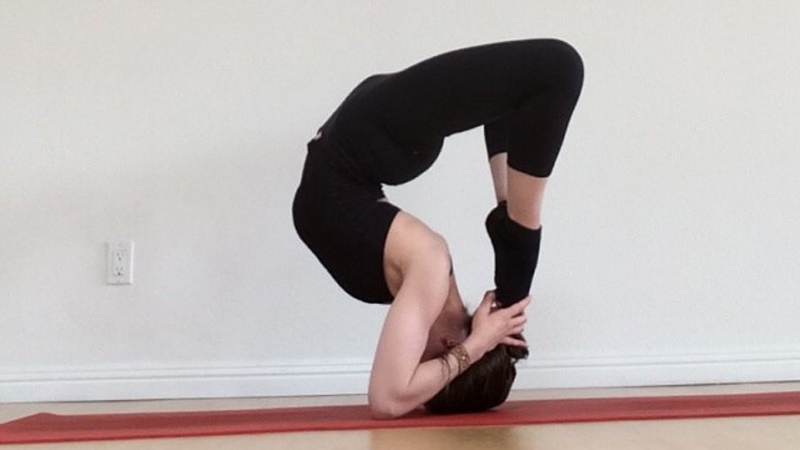শীর্ষপদাসন
যোগশাস্ত্রে বর্ণিত আসন বিশেষ। মাথায় পা রেখে শীর্ষাসন ভঙ্গিমাই হলো শীর্ষপদাসন। এটি শীর্ষাসনের একটি বর্ধিত প্রকরণ বিশেষ।
পদ্ধতি
১. প্রথমে একটু মোটা করে কম্বল বা কাঁথা বিছান। তারপর হাঁটু মুড়ে কক্বলের উপর বসুন।
২. এবার দুই কনুই-এর উপর ভর করে হামাগুড়ির ভঙ্গিতে স্থির হোন। দুই হাতের কনুই প্রসারিত অবস্থায় রেখে দুই হাতের আঙুলগুলো পরস্পরের ভিতরে নিয়ে আসুন।
৩. এবার অঙ্গুলিবদ্ধ হাতের তালুদ্বয়ের ভিতর মাথা রাখুন। তারপর হাঁটুকে মাথার কাছে নিয়ে আসুন। এবার মাথাকে ঘুরিয়ে হাঁটুর দিকে মুখ ফেরান। এর ফলে আপনার মাথার তালু মাটি স্পর্শ করবে।
৪. এবার মাথার উপর ভর দিয়ে, হাঁটু ভাঁজ থাকা অবস্থায় পা দুটো মাটির উপরে তুলতে থাকুন। এই অবস্থায় উরু পেট স্পর্শ করে থাকবে এবং পায়ের অগ্রভাগ বাইরের দিকে কিছুটা প্রসারিত অবস্থায় থাকবে।
৫. এবার পা দুটো সোজা করে, সম্পূর্ণ প্রসারিত করুন এবং শরীর একটি সরল দণ্ডের মতো অবস্থানে নিয়ে আসুন। তারপর পা দুটো ঘুরিয়ে মাথার পিছনে পায়ের অগ্রভাগ রাখুন। এই সময় পায়ের গোড়ালি কাঁধের উপর থাকবে।
৬. এই অবস্থায় ১০ সেকেণ্ড শরীর স্থির রাখুন। তারপর ধীরে ধীরে পা নামিয়ে আসন ত্যাগ করুন।
৭. এরপর ১০ সেকেণ্ড শবাসনে বিশ্রাম নিন। এরপর আরও দুইবার এই আসনটি করুন।
৮. প্রতিদিন এই আসন করে কিছুটা অভ্যস্থ হয়ে গেলে, ৩০ সেকেণ্ড পর্যন্ত আসন সময় বৃদ্ধি করতে পারেন। তবে প্রতিবার অন্তত ৩ বার আসনটি করুন।
বিশেষ সতর্কতা
উচ্চ-রক্তচাপ যাঁদের আছে, তাঁরা এই আসনটি করবেন না।
উপকারিতা
১. এই আসনে মস্তিষ্কে প্রচুর রক্ত সঞ্চালন হয়। ফলে, স্মৃতি শক্তি বৃদ্ধি পায়, মস্তিষ্কের অবসাদ ও অনিদ্রা দূর হয়। মস্তিষ্কের পিটিউটারি ও পিনেয়াল গ্রন্থি সক্রিয় হয়। ফলে শরীরের বৃদ্ধি ত্বরান্বিত হয়।
২. হৃদপিণ্ড ও ফুসফুসের ব্যায়াম হয়। রক্তে হিমোগ্লোবিনের পরিমাণ বৃদ্ধি পায়।
৩. সর্দি-কাশি, টনসিল জাতীয় রোগের উপশম হয়।
৪. মেয়েদের ঋতুস্রাবজনীত অনিয়ম দূর হয়।
शीर्ष पादासन
Sirsa padasana is an advanced backbend combined with a headstand. The name comes from the Sanskrit, sirsa, meaning “head”; pada, meaning “foot” or “feet”; and asana, meaning “pose” or “posture.”
To practice the pose, the yogi takes sirsasana (headstand) with the forearms resting on the ground, the hands clasped and the head resting in the triangle formed by the forearms. The legs then drop toward the back of the head as in vrishchikasana (scorpion pose). The drishti is toward the nose.
In English, sirsa padasana is known as feet-to-head pose or headstand with scorpion legs
Sirsa padasana is a posture that is often included in the two most advanced series of Ashtanga yoga: the fifth and sixth series. It is also an advanced posture in other styles of yoga. The late B.K.S. Iyengar, founder of Iyengar yoga, rated it as 52 out of 60 on his scale of difficulty. He described sirsa padasana as the most difficult of all backbends.
In addition to its physical benefits, which include a strong spinal stretch and increased blood flow to the brain, sirsa padasana develops concentration and focus. As a backbend, it is believed to open the anahata (heart center) chakra, which is associated with love, acceptance and empathy.



Comments
Sirsa Padasana
Pooja Sun, 13/Jun/2021 - 16:48
Sirsa Padasana